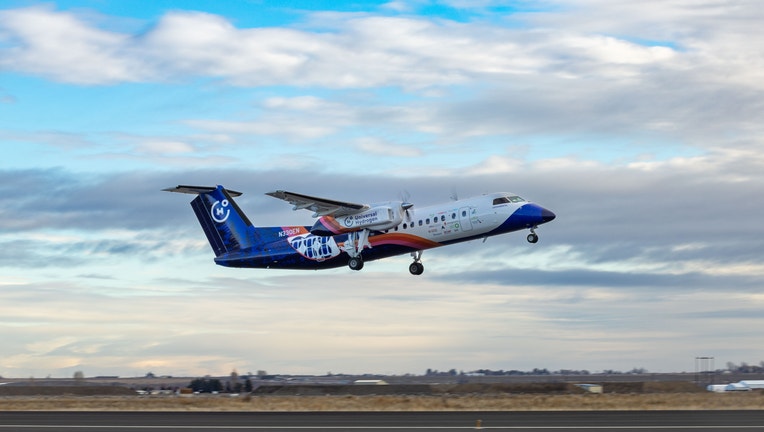Airplane aces US test flight running on pure hydrogen power

As airlines confront climate change, this retrofitted, hydrogen-powered plane was designed with hopes of beginning the "race" in the U.S. to reduce airlines’ carbon emissions.
A small plane retrofitted by a U.S. environmental company to run on something other than jet fuel aced its test flight earlier this month in Washington state.
The plane was retrofitted with the capability to run solely on hydrogen – which went "beautifully," according to the test pilot.
The hydrogen-powered plane was produced by Los Angeles-based Universal Hydrogen with the hopes of leading the "race" in the United States to reduce carbon emissions from airlines. Universal Hydrogen says its conversion kits for small planes can help bring its passenger service into zero emissions by 2025.
In September 2021, airline leaders and President Joe Biden touted an agreement to cut aircraft emissions 20% by 2030 and achieve net-zero greenhouse gas emissions by 2050.
There are multiple ways to consider achieving this goal: sustainable aviation fuel (SAF), (which is Biden administration’s favored approach), electric-powered planes – and the aforementioned hydrogen.
The hydrogen-powered plane from Universal Hydrogen that went on its historic test run was nicknamed Lightning McClean.
The plane took flight just before 8:45 the morning of Thursday, March 2, and was in the air for about 15 minutes. It reached a cruising altitude of 3,500 feet.
The plane, an ATR 72 regional aircraft, was retrofitted to keep one original fossil fuel turbine engine, as travelers know to be in planes today, alongside a second engine run solely on hydrogen power.
The test pilot, who has formerly flown with the U.S. Air Force, said he was able to completely cut back the original engine at one point and rely principally on hydrogen power.
"The airplane handled beautifully, and the noise and vibrations from the fuel cell (hydrogen) powertrain are significantly lower than from the conventional turbine engine," Alex Kroll said in a press release from Universal Hydrogen.
Universal Hydrogen is on deck to fulfill dozens of orders for hydrogen-powered regional planes that can transport passengers, including to Connect Airlines in the U.S.
The CEO for Connect Airlines, John Thomas, called Lightning McClean’s flight "the true start to the decarbonization of the global airline industry."
As Thomas continued to put it, hydrogen can be made "with nothing but sunshine and emitting only water."
RELATED: Climate in 2022: Extreme heat, drought, floods fueled by warming planet
Reducing flight emissions
Climate change concerns have created an existential crisis of sorts for air transport in the decades ahead.
Aviation releases only one-sixth the amount of carbon dioxide produced by cars and trucks, according to World Resources Institute, a nonprofit research group based in Washington. However, aviation is used by far fewer people per day.
Jet fuel use by the four biggest U.S. airlines – American, United, Delta and Southwest — rose 15% in the five years leading up to 2019, the last year before air travel dropped, even as they updated their fleets with more efficient planes.
Airlines have been announcing promises to become carbon neutral around the middle of the century, and some have invested in sustainable fuel as they defend against criticism over aviation’s role in climate change.
RELATED: Taylor Swift responds to critics after jet tops worst private plane CO2 emissions list
SAFs vs. electric vs. hydrogen
Sustainable fuel is biofuel made from cooking oil, animal fats, municipal waste or other feedstocks. Its chief advantage is that it can be blended with conventional fuel to power jet engines. It has been used many times on test flights and even regular flights with passengers on board.
Among SAF’s drawbacks are the high cost — about three times more than conventional jet fuel. As airlines seek to buy and use more of it, the price will rise further. Advocates are lobbying for tax breaks and other incentives to boost production.
Policymakers see SAF as a bridge fuel — a way to reduce emissions until more dramatic breakthroughs, such as electric- or hydrogen-powered planes, are ready. Those technologies might not be widely available for airline-size planes for two or three decades.
Several companies are designing and starting to build electric-powered planes, but most are small aircraft that take off and land vertically, like helicopters, and they are about the same size — with room for only a few passengers.
RELATED: Global carbon dioxide emissions reached a record high in 2022
Electric-powered planes big enough to carry around 200 passengers — a medium-size jet by airline standards — would require much bigger batteries for longer flights. The batteries would weigh about 40 times more than jet fuel to produce the same amount of power, making electric airliners impractical without huge leaps in battery technology.
Hydrogen, on the other hand, "is a very light fuel," Dan Rutherford, who leads the study of decarbonizing cars and planes for an environmental group, the International Council on Clean Transportation, told The Associated Press. "But you need a lot of volume to store it, and the fuel tanks themselves are heavy."
Despite that, Rutherford remained "cautiously optimistic" about hydrogen. His group believes that by 2035, there could be hydrogen-powered planes capable of flying about 2,100 miles.
Others, however, see obstacles including the need for massive and expensive new infrastructure at airports to store hydrogen that has been chilled into liquid form.
This story was reported from Detroit. The Associated Press contributed.

